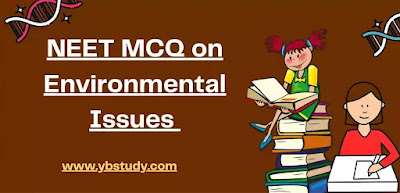MCQ on Environmental Issues with Answers Pdf | NEET
MCQ on Environmental Issues for NEET
Here in this article, We are providing you the MCQ on Environmental Issues Questions and Answers with Pdf asked in all the board and competitive entrance examinations such as NEET. Here first 21 MCQs are asked in NEET. We bring here Environmental Issues NEET MCQ Questions and Answers. which is very important from the NEET point of view. Multiple Choice Questions on Environmental Issues for NEET Aspirants are available for free, you can test your knowledge anytime and share the links with your friends to help them check their knowledge.
It will be very helpful for those students who are willing to get good Scores in their NEET exam. The practice below MCQ questions with a Pdf Download. All these questions are provided with answers and detailed explanations. Check out the MCQs provided below to get an idea of the type of questions to be asked in the NEET exam.
MCQ on Environmental Issues:
1. World ozone day is celebrated on_______
(a) 16th September
(b) 5th June
(c) 21st April
(d) 22nd April
Answer: A
2. The zone of the atmosphere in which the ozone layer is present is___________
(a) Troposphere
(b) Mesosphere
(c) Stratosphere
(d) ionosphere
Answer: C
3. Global warming can be controlled by__________
(a) Increasing deforestation, reducing the efficiency of energy use
(b) Reducing deforestation, cutting down the use of fossil fuel
(c) Reducing deforestation, increasing use of fossil fuel
(d) Increasing deforestation, slowing down the growth of the human population
Answer: B
4. Which one is the wrong statement?
(a) Ozone in the upper part of the atmosphere is harmful to animals
(b) Greenhouse effect is a natural phenomenon
(c) Eutrophication is a natural phenomenon in freshwater bodies
(d) Most of the forests have been lost in the tropical area
Answer: A
5. The dB is a standard abbreviation used for the quantitative expression of:
(a) A particular pollutant
(b) The dominant Bacillus in a culture
(c) A certain pesticide
(d) The density of bacteria in a medium
Answer: A
6. BOD in river water_________
(a) Remains unchanged when algal bloom occurs
(b) Increases when sewage gets mixed up with river water
(c) Has no relationship with the concentration of Oxygen in water
(d) Give a measure for Salmonella in water
Answer: B
7. Which particulate size is most harmful?
(a) 1.0 um or less
(b) 2.5 um or less
(c) 1.5 um or less
(d) 5.2 um -2.5 um
Answer: B
8. Consider the following statements
(i) – (iv) about organic farming:
(i) Utilizes genetically modified crops like Bt cotton
(ii) Uses only naturally produced inputs like Compost
(iii) Does not use pesticides and urea.
(iv) Produces vegetables rich in vitamins and minerals
Which of the above statements is correct?
(a) (ii) and (iii)
(b) (i) and (ii)
(c) (ii), (iii) and (iv)
(d) (iii) and (iv)
Answer: A
9. Which one of the following statements is not valid for aerosols?
(a) They are harmful to human health
(b) They alter rainfall and monsoon patterns
(c) They cause increased agricultural productivity
(d) They have a negative impact on agricultural land
Answer: C
10. Global agreement to reduce the release of ODS is__________
(a) Vienna Convention
(b) Rio de Janeiro Conference
(c) Kyoto Protocol
(d) Montreal Protocol
Answer: D
11. The Chipko movement was launched for the protection of_________
(a) Forests
(b) Grasslands
(c) Wetlands
(d) Livestock
Answer: A
12. Which one is the correct percentage of greenhouse gases?
(a) Methane -20%, N, O – 18%
(b) CFCs -14%, Methane-20%
(c) CO-40%, CFCs -30%
(d) NO-6%, CO2 -86%
Answer: B
13. Montreal protocol was passed in__________
(a) 1985
(b) 1986
(c) 1987
(d) 1988
Answer: C
14. Biochemical oxygen demand may not be a good index for water bodies receiving effluents from______
(a) Sugar industry
(b) Dairy industry
(c) Domestic sewage
(d) Petroleum industry
Answer: D
15. A river with the inflow of domestic sewage rich in organic waste may result in__________
(a) Drying of the river very soon due to algal bloom
(b) Increased population of fish due to biodegradable nutrients
(c) Increased population of aquatic food web organisms
(d) Death of fish due to lack of oxygen
Answer: D
16. Increase in concentration of the toxicant at successive trophic levels is known as_________
(a) Biogeochemical cycling
(b) Biomagnification
(c) Biodeterioration
(d) Biotransformation
Answer: B
17. Eutrophication of water bodies leading to the killing of fish is mainly due to the non-availability of_________
(a) Food
(b) Light
(c) Essential minerals
(d) Oxygen
Answer: D
18. Which of the following is the most suitable indicator of SO2 pollution in the environment_________
(a) Lichens
(b) Conifers
(c) Algae
(d) Fungi
Answer: A
19. Scrubber in the exhaust of a chemical industrial plant removes________
(a) Gases like sulfur dioxide
(b) Particulate matter of the six 5 micrometer or above
(c) Gases like ozone and methane
(d) Particulate matter of the size 2.5 micrometer or less
Answer: D
20. The Air Prevention and Control of Pollution Act. came into force in_______
(a) 1981
(b) 1990
(c) 1957
(d) 1985
Answer: A
21. In an area where DDT had been used extensively, the bird population declined significantly due to_________
(a) Birds stopped laying eggs
(b) Earthworms disappeared from the area
(c) Many of the bird’s eggs did not hatch
(d) Snakes started feeding extensively on birds
Answer: C
We hope that the above given Biology MCQs for Class 12 with Answers Chapter 16 Environmental Issues will help you with your NEET exam Preparation. If you have any queries regarding the above Environmental Issues Class 12 Biology MCQs Pdf, drop a comment below.

